Sequencing Primer: 9 Ways to Plan a Yoga Class
Yoga teachers, there are so many ways to sequence a class. Here's your primer, complete with 9 sample sequences, each with a different target.
Updated Jan 14, 2022

- Copy link
- Email
- Share on X
- Share on Facebook
- Share on Reddit
Heading out the door? Read this article on the new Outside+ app available now on iOS devices for members! >","name":"in-content-cta","type":"link">>'>Download the app.
Plus, want your best sequence promoted on YogaJournal.com? If you are a member of TeachersPlus, you can submit a sequence using the Sequence Builder tool for a chance to be featured to our readers, along with a $50 gift card to YogaOutlet. (TeachersPlus members also receive a host of other benefits, like discounts and free exclusive content! Find out more here, and share your sequence today!
Yoga class sequences come in different shapes and sizes. Every contemporary school, such as Iyengar, Viniyoga, Bikram, Ashtanga, and Vinyasa to name a few, has its own ideas about how to sequence a practice, so you may have already been trained to sequence your classes in a particular way. Most sequences are linear, that is one posture follows another in a logical step-by-step direction, moving from less challenging to more challenging and back to less challenging. In general, a sequence like this opens with simple warm-ups that set a theme for the practice, intensifies to more challenging postures, slows to cooling postures and ends with relaxation (Corpse Pose).
But this is just one way to sequence. Typically each posture in the sequence is performed just once but you could also have your students perform each posture two to three times, focusing on a different aspect of the posture each time. Take, for example, Trikonasana (Triangle Pose)–you can first teach the pose focusing on the feet or legs, then repeat it while focusing on the spine or arms. You can also build the entire sequence around just one posture, like Triangle, returning to it again and again, and use the other postures in the sequence to teach aspects of the main posture. Or you might design a sequence around a particular goal or benefit (alleviating back pain, say), around a particular body part (shoulders, perhaps), or around one type of pose (like backbends)
How to Plan a Linear Iyengar-Based Yoga Sequence
- Centering Begin the class with either a simple meditation or breathing exercise (in a seated or reclining position) so your students can collect and concentrate their awareness.
- Preparation Teach a few simple exercises (such as hip or groin openers) that warm up the body in preparation for the theme or focus of the practice.
- Sun Salute (Surya Namaskar) Instruct them through 3–10 rounds.
- Standing postures
- Arm balances
- Inversions
- Abdominal and/or arm strength postures
- Backbends
- Supported Shoulderstand
- Twists and/or forward bends
- Corpse Pose (Savasana)
A full practice sequence like this would take at least 90 minutes to finish, but not all classes go quite that long. Here are two possible sequences–one for beginners and one for advanced beginners–that would fit nicely into a shorter timeframe.
Sample Yoga Sequence for Beginners
You may also want to refer to this list of Beginners’ Poses.
- Sukhasana (Easy Pose)
- Adho Mukha Svanasana (Downward-Facing Dog Pose)
- Surya Namaskar–3 Rounds (Sun Salutations)
- Vrksasana (Tree Pose)
- Utthita Trikonasana (Extended Triangle Pose)
- Utthita Parsvakonasana (Extended Side Angle Pose)
- Dandasana (Staff Pose)
- Paschimottanasana (Seated Forward Bend)
- Baddha Konasana (Bound Angle Pose)
- Upavistha Konasana (Wide Angle Pose)
- Navasana (Boat Pose)
- Salabhasana (Locust Pose)
- Setu Bandha Sarvangasana (Supported Bridge Pose)
- Viparita Karani (Legs-Up-the-Wall Pose)
- Reclining Twist
- Savasana (Corpse Pose)
Sample Yoga Sequence for Advanced Beginners
- Virasana (Hero or Heroine Pose)
- Adho Mukha Svanasana (Downward-Facing Dog Pose)
- Surya Namaskar (Sun Salutations)
- Vrksasana (Tree Pose)
- Utthita Trikonasana (Extended Triangle Pose)
- Utthita Parsvakonasana (Extended Side Angle Pose)
- Ardha Chandrasana (Half Moon Pose)
- Adho Mukha Vrksasana (Handstand)
- Ardha Navasana (Half Boat Pose)
- Bhujangasana (Cobra Pose)
- Salabhasana (Locust Pose)
- Makrasana (Crocodile Pose)
- Salamba Sarvangasana (Supported Shoulderstand)
- Baddha Konasana (Bound Angle Pose)
- Janu Sirsasana (Head-to-Knee Forward Bend)
- Paschimottanasana (Seated Forward Bend)
- Marichyasana III (Marichi’s Pose, Variation III)
- Savasana (Corpse Pose)
How to Design a Yoga Sequence for Headaches
There are many different kinds of headaches, some (like tension headaches and migraines) are fairly common, others (like sinus headaches or headaches caused by brain tumors) are relatively rare. Various treatments–including drugs, acupuncture, chiropractic and massage, and stress-relief techniques–are recommended for dealing with headaches. Yoga asanas and breathing can help too, though mostly with tension-type headaches.
Here’s a sequence you can teach to a student who is suffering from a tension headache. Whenever possible, get the student practicing soon after she starts to feel the pain. Once the headache is established it will be very difficult to alleviate. You can also explore Yoga Poses for Headaches.

Sample Yoga Sequence for a Headache
Minimum time 25 minutes, maximum time 45 minutes
- Balasana (Child’s Pose) Have the student place her head on the floor, or support her torso and head on a bolster positioned between her thighs. The bolster’s long axis should be parallel to her torso. (Total time 3 to 5 minutes.)
- Janu Sirsasana (Head-to-Knee Pose) Support her head either on a bolster laid across her extended leg, or, if she’s less flexible, on the front edge of a padded chair seat. Hold each side for 1 to 3 minutes; total time 2 to 6 minutes.
- Adho Mukha Svanasana (Downward-Facing Dog) Support her head on a bolster or block. (Total time 1 to 2 minutes.)
- Uttanasana (Standing Forward Bend) Place her head and crossed forearms supported on a padded chair seat. (Total time 1 to 3 minutes.)
- Supta Baddha Konasana (Reclining Bound Angle Pose) Support the torso on a rolled blanket underneath and parallel to her spine. (Total time 3 to 5 minutes.)
- Setu Bandha Sarvangasana (Supported Bridge Pose) Support the torso on a bolster, and instruct her to let her shoulders and head rest lightly on the floor. (Total time 3 to 5 minutes.)
- Viparita Karani (Legs-Up-the-Wall Pose) Let her pelvis be supported either on a bolster or rolled blanket. (Total time 3 to 5 minutes.) To protect her back when exiting, make sure she doesn’t twist off the support. Either instruct her to 1) slide off the support first before turning to her side, or 2) bend her knees, press her feet against the wall, and with an inhalation lift her pelvis off the support; then slide the support off to one side, lower her pelvis to the floor, and turn onto her side.
- Savasana (Corpse Pose) Ask her to take normal inhalations but lengthen the exhalations as much as is comfortable. If she normally takes 5 counts on an exhalation, extend it to 7 or 8 counts if possible. At the end of the first 10 or so exhalations, pause for 2 to 5 seconds before drawing the next inhalation. (Total time 10 to 15 minutes.)
When in Corpse Pose she might also want to lay a weighted sandbag on her forehead. Have her lie in Corpse and position a block so that it’s touching the top of her head. Its long axis should be perpendicular to her head. Lay the weighted bag half on the block and half on her forehead. The pressure of the weight on her head helps release the tension.
How to Plan a Yoga Sequence for Menstruation
Exercise during menstruation is generally highly recommended. It’s believed that exercise can ease the discomfort of dysmenorrhea; quell mood swings, anxiety, and depression; and reduce bloating.
Most contemporary yoga teachers advise a fairly conservative approach toward asana practice during menstruation. These menstrual sequences generally consist of prop-supported poses-mostly forward bends. This makes perfect sense for women who feel sluggish during their cycle. However, many other women don’t feel the need to change anything about their practice during menstruation, except maybe to limit strenuous inverted poses. Each student should decide for herself what kind of asana sequence is most appropriate for her body during menstruation, but here are some poses you can offer as a start. You can also refer to Yoga Poses for Menstruation.
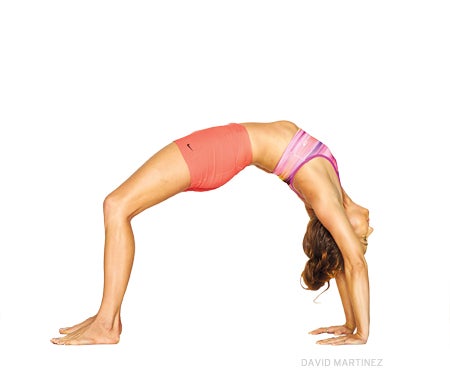
Sample Yoga Sequence for Menstruation
Minimum time 45 minutes, maximum time 60 minutes
- Supta Baddha Konasana (Reclining Bound Angle Pose) Support the torso on a bolster. (Total time 5 minutes.)
- Supta Padangusthasana (Reclining Big Toe Pose) Use a strap to hold the raised leg in place. Hold each side for 2 minutes; total time 4 minutes.
- Baddha Konasana (Bound Angle Pose)(Total time 2 minutes.)
- Janu Sirsasana (Head-to-Knee Pose) Support the head either on a bolster laid across her extended leg, or if she’s less flexible, on the front edge of a padded chair seat. Hold each side for 3 to 5 minutes; total time 6 to 10 minutes.
- Paschimottanasana (Seated Forward Bend) With her torso and head supported on a bolster laid along her legs. (Total time 3 to 5 minutes.)
- Upavistha Konasana (Seated Wide-Angle Pose) Rest the torso on a bolster positioned between her legs with its long axis parallel to her torso. (Total time 3 to 5 minutes). Then have her come up and twist to each side for 30 seconds to 1 minute, holding the shin or the inside of the foot. (Total time 1 to 2 minutes.)
- Urdhva Dhanurasana (Upward-Facing Bow) Supported on a chair. Pad the chair seat with either a sticky mat or a folded blanket. Then ask her to slide her legs through the space between the chair back and seat, and sit on the back edge of the seat facing the chair back. Have her grip the chair legs just below the chair back and, with an exhalation, lean into a backbend. The front edge of the seat should cross her back torso just under her shoulder blades. Instruct her to keep her knees bent and feet on the floor. Support the back of her head, either on a bolster or a block. She can continue to hold the chair legs, stretch her arms overhead, or slip her arms underneath the seat between the chair legs and grip the back rung. Make sure she is breathing smoothly. To come up, ask her to grip the chair legs just below the chair back, and pull herself up with an exhalation. Ask her to lead the movement of her torso with her chest, not her head. (Total time 3 to 5 minutes.)
- Seated Twist Still sitting reversed through the chair, ask her to twist to the right with an exhalation, hold for 30 seconds, then twist to the left for 30 seconds. Repeat three times to each side, each time holding for 30 seconds. (Total time 3 minutes.)
- Viparita Karani (Legs-Up-the-Wall Pose) Support her pelvis on a bolster or rolled blanket. (Total time 5 to 10 minutes.) Make sure she slides off the support before turning to her side.
- Savasana (Corpse)(Total time 8 to 10 minutes.)
How to Design a Yoga Sequence for Depression
The word “depression” covers a wide range of conditions, from long-standing and severe clinical or major depression to shorter-term and episodic mild depression, also called dysthymic disorder, to situational depression brought on by a major life change, such as the death of a spouse, job loss, divorce.
Many different therapies are available for depression, including anti-depressants and psychotherapy. Studies indicate that regular exercise too, including yoga asanas and breathing, can help some people ease the symptoms of mild to moderate forms of depression. Here is a sequence you can try with students suffering from this condition. You may also want to refer to Yoga Poses for Depression.
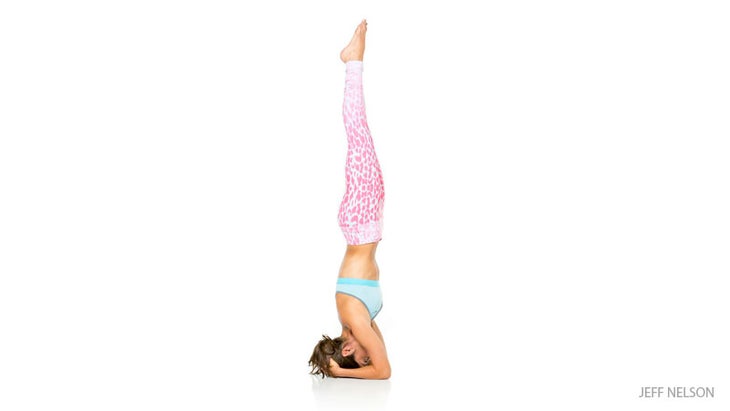
Sample Yoga Sequence for Depression
Minimum time 40 minutes, maximum time 70 minutes
- Supta Baddha Konasana (Reclining Bound Angle Pose) with her back torso supported on a rolled blanket positioned below and parallel to her spine. (Total time 3 to 5 minutes.)
- Supta Padangusthasana (Reclining Big Toe Pose) Ask her to use a strap to hold the raised leg in place. Hold each side for 1 to 2 minutes; total time 2 to 4 minutes.
- Adho Mukha Svanasana (Downward Facing Dog) Use a bolster or block to support the head. (Total time 1 to 2 minutes.)
- Uttanasana (Standing Forward Bend) Support her head and crossed forearms on a padded chair seat. (Total time 1 to 3 minutes.)
- Sirsasana (Headstand) Intermediate students should perform the full pose for a total time of 3 to 5 minutes. Ask them to bring their feet back to the floor slowly together if possible, either with straight knees or bent, with an exhalation, and stand in Standing Forward Bend for 30 seconds before coming up. (Total time 3 minutes.)
- Urdhva Dhanurasana (Upward Bow Pose) Supported on a chair. Pad the chair seat either with a sticky mat or folded blanket. Then ask her to slide her legs through the space between the chair back and seat, and sit on the back edge of the seat facing the chair back. Instruct her to grip the chair legs just below the chair back and, with an exhalation, lean into a backbend. The front edge of the seat should cross her back torso just under her shoulder blades. Have her keep her knees bent and feet on the floor. Support the back of her head, either on a bolster or a block. She can continue to hold the chair legs, stretch her arms overhead, or slip her arms underneath the seat between the chair legs and grip the back rung. Make sure she is breathing smoothly.To come up, ask her to grip the chair legs just below the chair back, and pull herself up with an exhalation. Make sure she leads the movement of her torso with her chest, not her head. (Total time 3 to 5 minutes.)
- Seated twist Continue to sit reversed through the chair, then ask her to twist to the right with an exhalation, hold for 30 seconds, then twist to the left for 30 seconds. Repeat three times to each side, each time holding for 30 seconds. (Total time 3 minutes.)
- Setu Bandha Sarvangasana (Bridge Pose) Place a blank under the shoulders for support. Repeat three times, each time for 30 seconds to 1 minute. (Total time 2 to 3 minutes.)
- Salamba Sarvangasana (Shoulderstand)(Total time 3 to 5 minutes.) Follow Shoulderstand with Halasana (Plow Pose). Intermediate students should do full Plow with their feet on the floor, beginners can do Plow with their feet resting on a chair seat. (Total time 1 to 2 minutes.)
- Janu Sirsasana (Head-to-Knee Forward Bend) Support the head either on a bolster laid across her extended leg, or if she’s less flexible, on the front edge of a padded chair seat. Hold each side for 1 to 3 minutes; total time 2 to 6 minutes.
- Setu Bandha Sarvangasana (Supported Bridge Pose) Allow her torso to be supported on a bolster, and shoulders and head to rest lightly on the floor. Ask her to keep her knees bent and feet on the floor. (Total time 3 to 5 minutes.)
- Viparita Karani (Legs-Up-the-Wall Pose) Pelvis is supported on a bolster or rolled blanket. (Total time 3 to 5 minutes.) Ask her to slide off the support before she turns to her side.
- Reclining Conqueror Ujjayi Instruct her to lie on a blanket support to open her chest, with long, smooth, full inhalations and exhalations. (Total time 3 to 5 minutes.)
- Savasana (Corpse Pose) Instruct her to come off her blanket support and lay her back torso flat on the floor. Support her bent knees on a bolster. (Total time 8 to 10 minutes.)
EXPLORE MORE Poses By Benefit
How to Design a Yoga Sequence for the Groins
My dictionary notes that the English word groin “perhaps” derives from the Old English grynde, which means “hollow.” The groins are indeed hollows, located at the junctions between the thighs and pelvis. For the purposes of yoga instruction (though this is not technically correct according to anatomy textbooks), we can distinguish between the front groins and the inner groins. The front groins refer to the creases running from the hip points (the two little bony knobs a few inches to either side of the navel) diagonally down and into the pubic bone (the front bottom of the pelvis), which together form a “V” shape. The inner groins extend from the creases between the inner thighs and the perineum (the fleshy base of the pelvis). Any groin sequence should work with both these pairs of groins. You can also refer to Yoga Poses for the Pelvis.
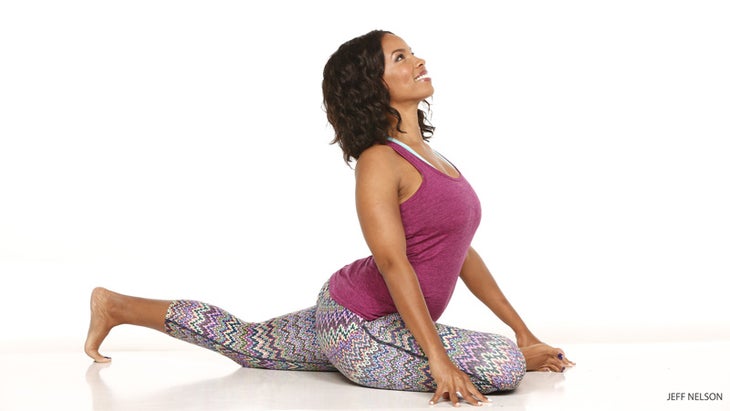
Sample Yoga Sequence for Groins
Total time 45 to 55 minutes
- Supta Baddha Konasana (Reclining Bound Angle Pose) Ask her to start in Supta Baddha Konasana with the back of her pelvis flat on the floor. Then after a minute or so, place a block underneath her sacrum. She will eventually place the block at its highest height, but if the sensation is too intense, she can lower it. (Total time two to three minutes).
- Supta Virasana (Reclining Hero Pose) If she can’t recline comfortably on the floor, make sure that her back torso is well-supported on a bolster. Place a heavy sandbag on the front groin of the bent leg, right over the head of the thighbone. Keep each leg in position for two to three minutes (Total time four to six minutes). Alternative: If Supta Virasana is painful for her knees, review the instructions in our Poses section. If she still finds the pose uncomfortable, have her take a low lunge at the wall as follows: Start by facing the wall. Place her right big toe at the wall and slide her left knee back into a low lunge. (The top of your her foot and left knee will rest on the floor.) Press her hands into the wall for support. Repeat on the other side.
- Supta Padangustasana (Reclining Hand-to-Big-Toe Pose)
Hold each leg vertical for one to two minutes, then open the leg out to the side (resting the outer thigh on a block) for the same length of time. (Total time four to eight minutes).
- Adho Mukha Svanasana (Downward-Facing Dog Pose)
Keep her in the pose for one minute. Then ask her to step the right leg forward into the leg position for:
- Eka Pada Rajakapotasana (One-Legged King Pigeon Pose)
Ask her to lay her torso down on the inner front thigh for one to two minutes. Then have her step lightly back into Adho Mukha Svanasana, hold for 30 seconds, and repeat with the left leg forward for the same length of time. (Total time of steps four and five: five to seven minutes).
- Prasarita Padottanasana (Wide-Legged Standing Forward Bend) with a variation
With the legs wide, have her bend her right knee and shift her torso to the right, snugging it against the inner thigh. Instruct her to keep the left leg strong, pressing the inner thigh out to the left. Hold for one minute. Inhale back to center, then repeat to the left for the same length of time. Finally, perform the full pose for two minutes. (Total time four minutes)
- Utthita Parsvakonasana (Extended Side Angle Pose)
Perform with the bottom arm pressing against the inner thigh. Hold each side for one to two minutes (Total time two to four minutes).
- Vrksasana (Tree Pose)
Hold each side for minute (Total time two minutes).
- Upavistha Konasana (Wide Angle Seated Forward Bend) with a variation
- First have her twist to the right for one minute, then to the left for the same length of time. Return to center and fold forward for one to three minutes (Total time three to five minutes) .
- Janu Sirsasana (Head-to-Knee Pose)
Fold forward for two minutes on a side (Total time four minutes)
- Malasana (Garland Pose)
(Total time two minutes).
- Setu Bandha Sarvangasana (Bridge Pose)
Place a block underneath her sacrum for support. (Total time two to three minutes)
- Salamba Sarvangasana (Supported Shoulderstand) with a variation
Instruct her to come into Shoulderstand and then bend the knees and press the soles of the feet together in Baddha Konasana (Bound Angle Pose). (Total time three minutes).
- Savasana (Corpse Pose)
(Total time 10 minutes).
How to Plan a Yoga Sequence for the Shoulders
One giveaway of poor posture, often the result of the stresses and strains of daily life, is rounded shoulders. When we hold ourselves this way, our upper back hunches, lifting the shoulders toward the ears, and our chest collapses, narrowing the space between the collarbones. All of this can lead to the head jutting forward, which creates compression and tightening in the neck. This condition creates the potential for any number of physical ailments, including chronic headaches, back pain, and breathing difficulties. A shoulder sequence should include stretches that open and lift the heart area, and exercises that draw the shoulder blades down the back and return the head to a neutral position, perched lightly on the top of the spine. You can also refer to Yoga Poses for the Shoulders.
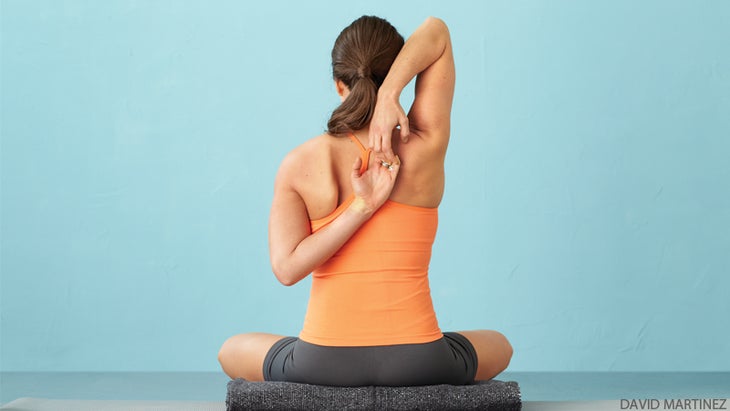
Sample Yoga Sequence for Shoulders
Total time 45 to 55 minutes
- Sukhasana (Easy Pose) or Virasana (Hero Pose) Ask her to find a seated position that is comfortable for her, and make sure you have a strap nearby. Keeping the hands well apart, have her hold the strap in both hands with the arms stretched forward and parallel to the floor. Ask her to inhale and sweep the strap above her head, then exhale as she brings it down behind her torso. Next, have her inhale the strap up again above her head, then down in front of her torso on the exhalation. Be sure she keeps her elbows straight and her shoulders away from her ears. Repeat 10 to 15 times (Total time three minutes) .
- Gomukhasana (CowFace Pose) arm position
Have her take the right arm on top first. Hold for one minute. Then perform the arm position for Garudasana (Eagle Pose), right arm above the left, for the same length of time. Repeat with the left arm superior for the same length of time (Total time four minutes) .
- Adho Mukha Svanasana (Downward-Facing Dog Pose)
Ask her to come into Downward Dog with her fingertips grazing the edge of a wall. Hold for 30 seconds to two minutes. When she inhales, instruct her to swing her torso forward until the crown of her head presses against the wall in a variation of Plank Pose. Hold for one to two minutes, spreading the shoulder blades wide. Return to Adho Mukha Svanasana for 30 seconds to two minutes, then Plank again for one to two minutes. Finally release her knees to the floor (Total time three to four minutes)
- Pincha Mayurasana (Forearm Balance)
Perform at the wall for one minute. If you’d like, you can ask her to repeat for the same length of time, kicking up with her non-habitual leg.
- Adho Mukha Vrksasana (Handstand)
Take Handstand at the wall for one minute. As in Forearm Balance, you can repeat for the same length of time, asking her to kick up with her non-habitual leg. If she is not yet working on Handstand, try Half Handstand at the wall. Measure off a leg’s distance from the wall by sitting in Dandasana (Staff Pose) with the heels pressing against the wall. Have her turn around so that she is facing away from the wall and take Downward-Facing Dog. Ask her to place her hands where her hips were in Dandasana. Have her slowly walk her feet up the wall so until they are parallel with her hips.
- Tadasana(Mountain Pose) with Anjali Mudra (Salutation Seal)
Spread and press the palms in Anjali Mudra. Use these actions to create a similar spreading and firmness of the shoulder blades on the back torso. (Total time two minutes) .
- Parsvottanasana (Intense Side Stretch Pose)
Place the hands in reverse Anjali Mudra, pressing behind the back. Or you can cross the forearms behind the back and clasp hold of the elbows. Be sure to reverse the cross on the other side. Ask her to hold for one minute on each side. In between each side, and at the conclusion of the second side, put her in Prasarita Padottanasana II (with the hands on the waist) for one minute. (Total time four minutes).
- Virabhadrasana I (Warrior Pose I)
One minute on each side. (Total time two minutes)
- Vasisthasana (Pose Dedicated to the Sage Vasistha)
One minute on each side (Total time two minutes)
- Setu Bandha Sarvangasana (Bridge Pose) with a variation
Ask her to sit with her knees bent and feet flat on the floor, hips distance apart. Then have her place a strap around the ankles and lie back. Instruct her to come into Bridge Pose with the hands on the strap. Have her hold it and walk the hands up the strap, toward the feet. Make sure she keeps the shoulder blades drawing down the back. Repeat three times, each time for one minute. (Total time three minutes) .
- Purvottanasana (Upward Plank Pose)
Two to three times, holding for 30 seconds to one minute each time. (Total time one to three minutes) . Alternative: Tabletop the pose with the knees bent and feet flat on the floor.
- Dhanurasana (Bow Pose)
Two to three times, holding for 30 seconds to one minute each time. (Total time one to three minutes)
- Bharadvajasana (Bharadvaja’s Twist)
One minute on each side (Total time two minutes)
- Salamba Sarvangasana (Supported Shoulderstand)
Work up to five minutes. Finish with Halasana (Plow Pose) for one to two minutes. (Total time six to seven minutes).
- Savasana (Corpse Pose)(Total time 10 minutes).
EXPLORE MORE Poses By Anatomy
How to Plan a Forward-Bending Yoga Sequence
Forward bends are typically thought of as poses that direct our awareness away from the outside world and toward the inner world. While the back of the body is being stretched in forward bends, particularly the backs of the legs, our attention should continually be focused on the front torso. Always tip into a forward bend from the groins, being sure to maintain the length of the front torso, especially the lower belly between the pubic bone (the front bottom of the pelvis) and the navel. As soon as you begin to feel this area shorten, you should stop the forward movement, lift out of the pose slightly, reestablish the length of the lower belly, and then try to bend forward again. You may also want to explore more Forward Bends.
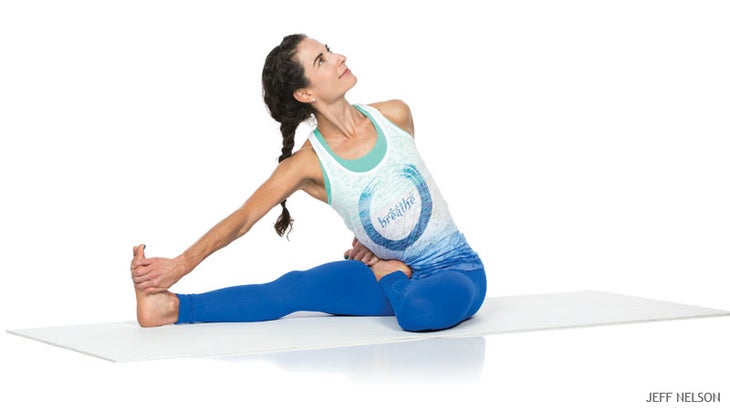
Sample Yoga Sequence of Forward Bends
Total time 50 to 70 minutes
- Supta Padangustasana (Reclining Hand-to-Big-Toe Pose)
Right leg vertical for one to two minutes, then leg out to the side, resting the outer thigh on a block for the same length of time. Repeat with the left leg for the same length of time. (Total time two to four minutes) .
- Dandasana (Staff Pose)
One minute, then, with an exhalation, draw the legs into:
- Baddha Konasana (Bound Angle Pose)
Hold for one minute, then with an inhalation, lightly extend the legs back into Dandasana. (Total time for steps two and three: two minutes) .
- Janu Sirsasana (Head-to-knee Pose)
Hold for two to three minutes on a side. (Total time four to six minutes) .
- Ardha Baddha Padmottanasana (Half-Bound Half-Lotus Forward Bend)
Hold for two to three minutes on each side. (Total time four to six minutes) .
- Trianga Mukhaikapada Paschimottanasana (Three-Limbed Forward Bend)
Hold for two to three minutes on each side. (Total time four to six minutes) .
- Krounchasana (Heron Pose)
Hold for one to two minutes on each side. (Total time four to six minutes) .
- Marichyasana I (Pose Dedicated to the Sage Marichi)
Hold for one to two minutes on each side. (Total time four to six minutes) .
- Paschimottanasana (Seated Forward Bend)
(Total time two to three minutes).
- Upavistha Konasana (Wide-Angle Seated Forward Bend)
First have her twist to the right for one minute, then to the left for the same length of time. Ask her to return to center and fold forward for two minutes. (Total time four minutes) .
- Tadasana (Mountain Pose)
(Total time one minute).
- Uttanasana (Standing Forward Bend)
(Total time one to two minutes).
- Utthita Trikonasana (Extended Triangle Pose)
For one minute on each side. (Total time two minutes) .
- Utthita Parsvottanasana (Extended Side Stretch Pose)
Ask her to place the hands on the floor on either side of the front foot. Hold for one minute on each side. (Total time two minutes) .
- Prasarita Padottanasana (Wide-Legged Standing Forward Bend)
(Total time one to two minutes).
- Salamba Sarvangasana (Supported Shoulderstand)
(Total time three to five minutes).
- Halasana (Plow Pose)
(Total time one to three minutes).
- Savasana (Corpse Pose)
(Total time 10 minutes)
How to Plan a Backbending Yoga Sequence
Backbends are thought of as poses that open our awareness to the outside world. While the front of the body is being stretched in backbends (specifically the thighs, front groins, belly, chest and armpits), we should continue to focus our students’ attention on the back torso. As they come into a backbend, ask them to lift the pubic bone toward the navel and rotate the thighs strongly inward. Make sure they keep the buttocks firm (but not tight or squeezed) and keep the tailbone pressed forward, which helps keep the lower back long and protects it from compression. Refer to this list of Backbends to learn more.
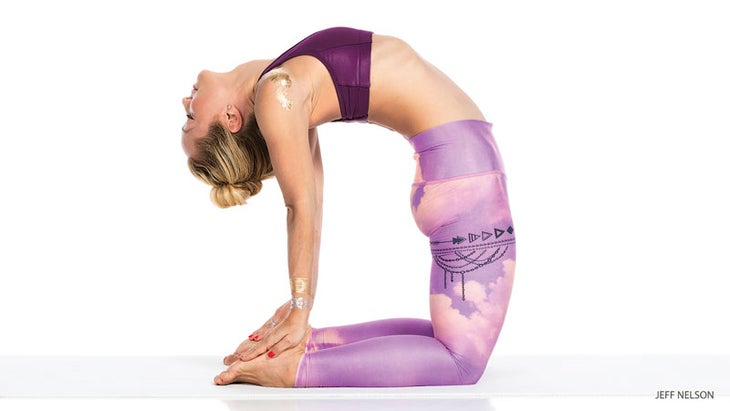
Sample Yoga Sequence of Backbends
Total time 40 to 50 minutes
- Virasana (Hero Pose)
Ask her to clasp her hands and stretch the arms straight out in front of her with the palms facing away from you. Then as she inhales have her stretch the arms up alongside the ears. Hold for one minute. Allow her to release, reverse the clasp of the hands (do the non-habitual clasp) and again raise her arms for one minute. Release on an exhalation. (Total time two minutes) .
- Supta Virasana (Reclining Hero Pose)
(Total time two to three minutes).
- Gomukhasana (Cow Face Pose)
For one to two minutes on each side (Total time two to four minutes) .
- Adho Mukha Svanasana (Downward-Facing Dog Pose)
(Total time one minute).
- Adho Mukha Vrksasana (Handstand)
Have her perform this pose very close to the wall. Once she has kicked up, ask her to press the buttocks and the backs of the legs into the wall, and lift the chest away from the wall. Hold her in the posture for 30 seconds, then ask her to press through the arms and reach through heels into the full pose for 30 seconds. (Total time one minute)
- Tadasana (Mountain Pose)
(Total time one minute). Then feet apart for:
- Utthita Parsvakonasana(Extended Side Angle Pose)
Guide her into the pose, then ask her to walk the bottom hand a few inches behind her so that she has space to come into a backbend in the upper-back. Hold each side for one minute. (Total time two minutes)
- Virabhadrasana I (Warrior I)
One minute on each side (Total time two minutes) .
- Purvottanasana (Side Stretch Pose)
Repeat three times, holding for 30 seconds to one minute each time. (Total time two to three minutes) .
- Bhujangasana (Cobra Pose)
Repeat three times, holding for 30 seconds to one minute each time. (Total time two to three minutes) .
- Salabhasana (Locust Pose)
Repeat three times, holding for 30 seconds to one minute each time. (Total time two to three minutes) .
- Dhanurasana (Bow Pose)
(Total time one minute).
- Ustrasana (Camel Pose)
(Total time one minute).
- Urdhva Dhanurasana (Upward Bow)
Repeat three to five times, holding for 15 to 30 seconds each time. (Total time one to three minutes) .
- Salamba Sarvangasana (Supported Shoulderstand)
Hold for three to five minutes, then have her drop to:
- Setu Bandha Sarvangasana (Bridge Pose)
(Total time one minute).
- Matsyasana (Fish Pose)
(Total time 30 seconds to one minute).
- Marichyasana III (Pose Dedicated to the Sage Marichi)
Ask her to twist to each side three times, holding each twist for 30 seconds. (Total time three minutes)
- Savasana (Corpse Pose)
(Total time 10 minutes).
EXPLORE MORE Types of Poses
Want to Learn More?
Here’s a list of books we recommend to refine your sequencing skills.
- Anderson, Sandra, and Rolf Sovik. Yoga: Mastering the Basics (Honesdale, PA: Himalayan Institute Press, 2002).
- Bender Birch, Beryl. Power Yoga (New York: Fireside Press, 1995).
- Couch, Jean. The Runner’s Yoga Book (Berkeley, CA: Rodmell Press, 1990.
- Desikachar, T.K.V.. The Heart of Yoga (Rochester, VT: Inner Traditions, 1995).
- Farhi, Donna. Yoga Mind, Body & Spirit (New York: Henry Holt, 2000).
- Feuerstein, Georg and Larry Payne. Yoga for Dummies (Hoboken, NJ: Wiley Publishing, 1999).
- Frawley, David and Sandra Summerfield Kozak. Yoga for Your Type (Twin Lakes, WI: Lotus, 2001).
- Grilley, Paul. Yin Yoga (Ashland, OR: White Cloud, 2002).
- Iyengar, B.K.S. Light on Yoga (New York: Schocken, 1995).
- Iyengar, B.K.S.. Yoga: The Path to Holistic Health (New York: Dorling Kindersley, 2001).
- Kraftsow, Gary. Yoga for Transformation (New York: Penguin Compass, 2002).
- Mehta, Mira. How to Use Yoga (Berkeley, CA: Rodmell Press, 1998).
- Mohan, A.G.. Yoga For Body, Breath, and Mind (Portland, OR: Rudra Press, 1993).
- Browning Miller, Elise and Carol Blackman. Life is a Stretch (St. Paul, MY: Llewellyn, 1999).
- Schiffmann, Erich. Yoga: The Spirit and Practice of Moving Into Stillness (New York, Pocket Books, 1996).
- Sparrowe, Linda and Patricia Walden. The Woman’s Book of Yoga & Health (Boston, MA: Shambhala Publications, 2002).
- Goad Trechsel, Jane. A Morning Cup of Yoga (Birmingham, AL: Crane Hill Publishers, 2002).
- Vishnu-devananda, Swami. The Complete Illustrated Book of Yoga (New York: Crown, 1995).
- Yee, Rodney with Nina Zolotow. Yoga: The Poetry of the Body (New York: St. Martin’s Press, 2002).
ABOUT OUR EXPERT
Richard Rosen, who teaches in Oakland and Berkeley, California, has been writing for Yoga Journal since the 1970s.
Please note that we independently source all of the products that we feature on yogajournal.com. If you buy from the links on our site, we may receive an affiliate commission, which in turn supports our work.

Richard Rosen started practicing yoga at the Yoga Room in Berkeley, CA. He and his friend Rodney Yee opened the Piedmont Yoga Studio in Oakland, CA, (1987-2012). He is the author of five books about yoga, including "The Yoga of Breath: A Step-by-Step Guide to Pranayama" and "Original Yoga: Rediscovering Traditional Practices of Hatha Yoga."










